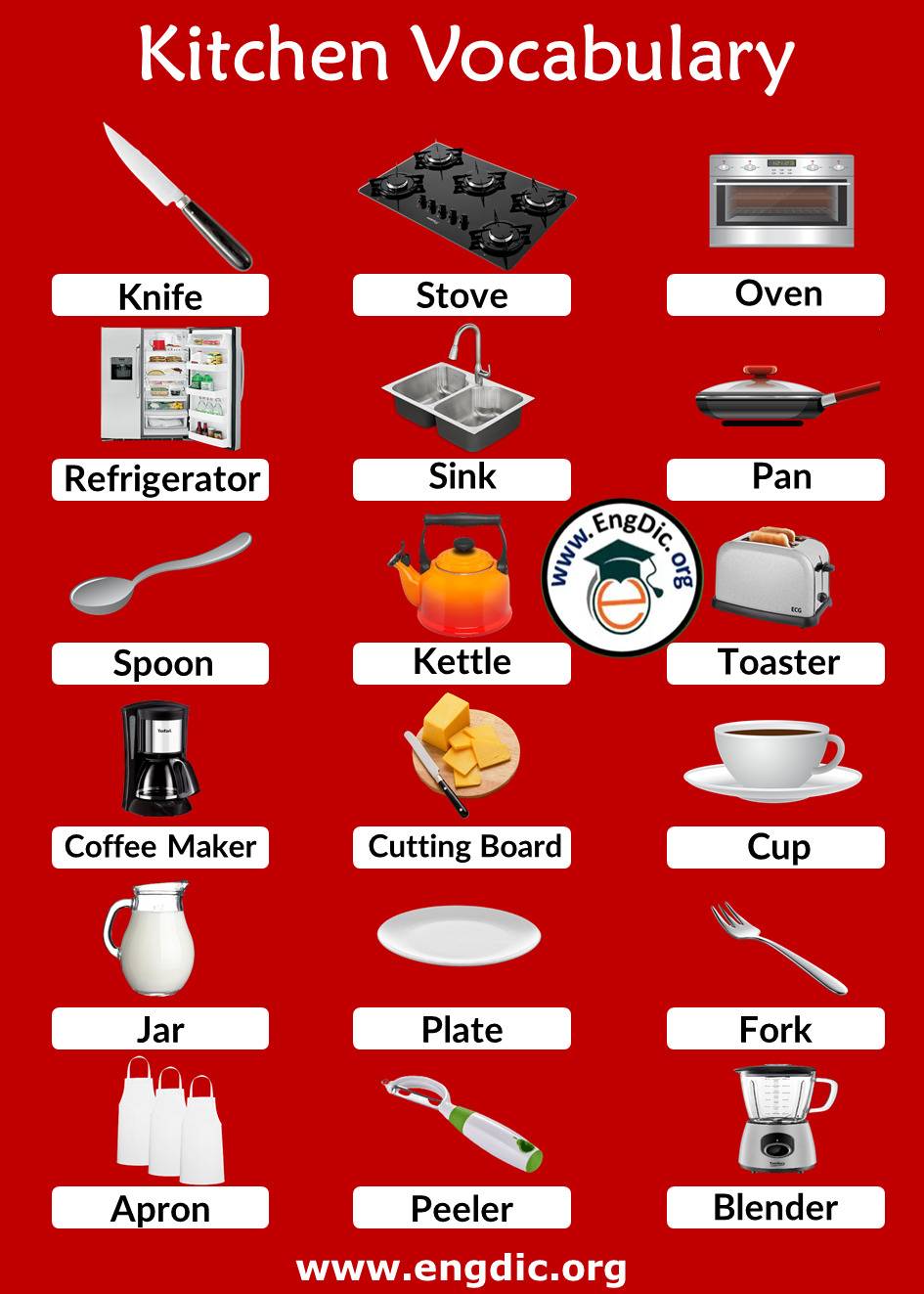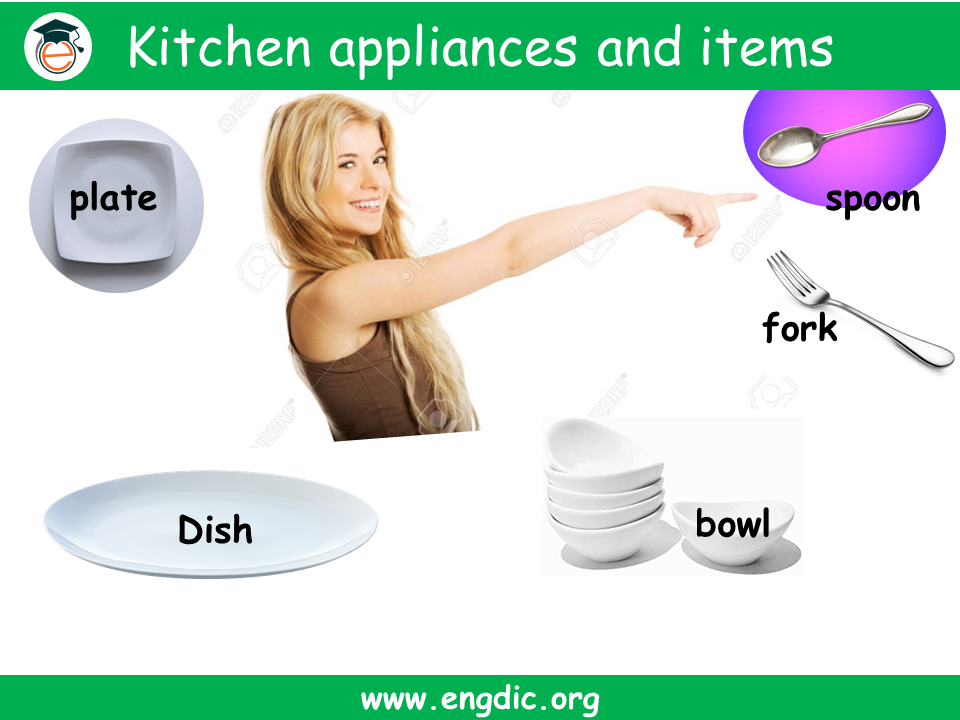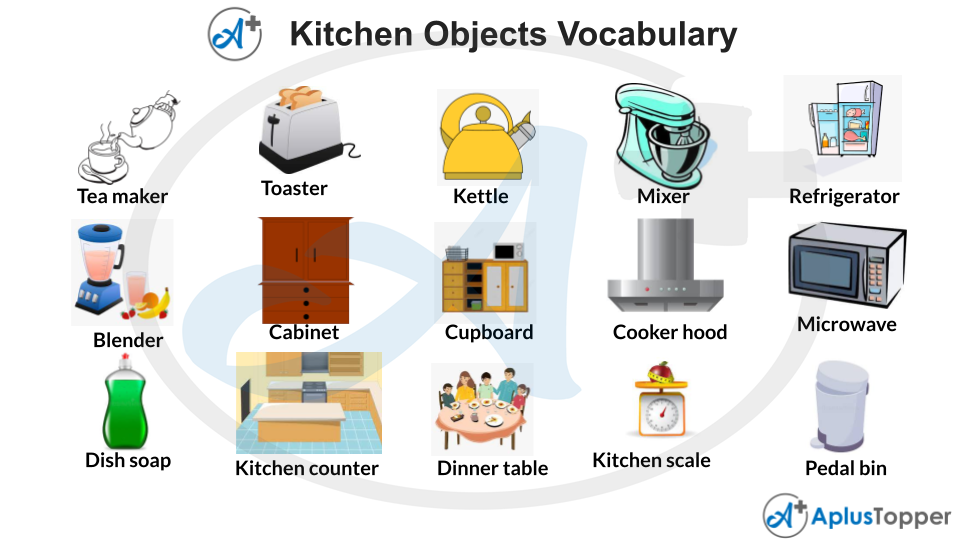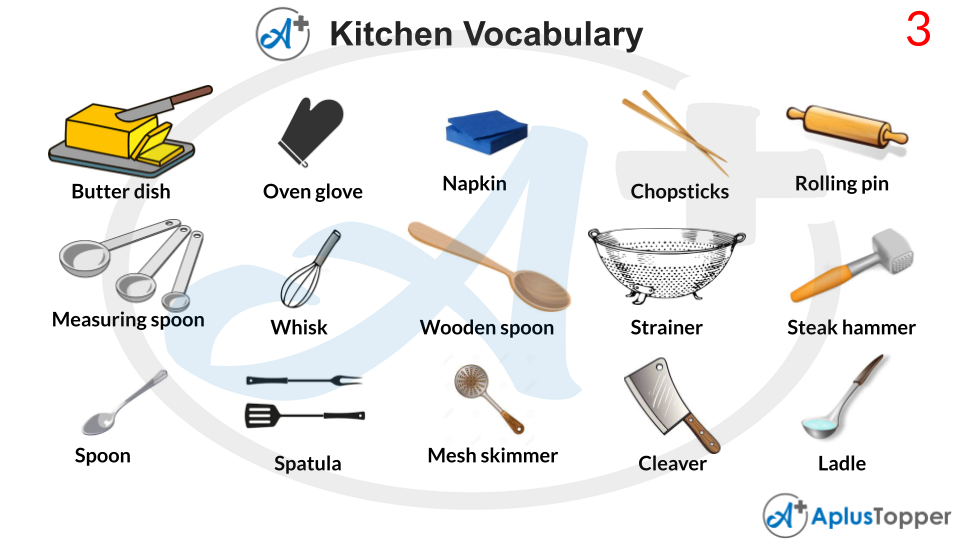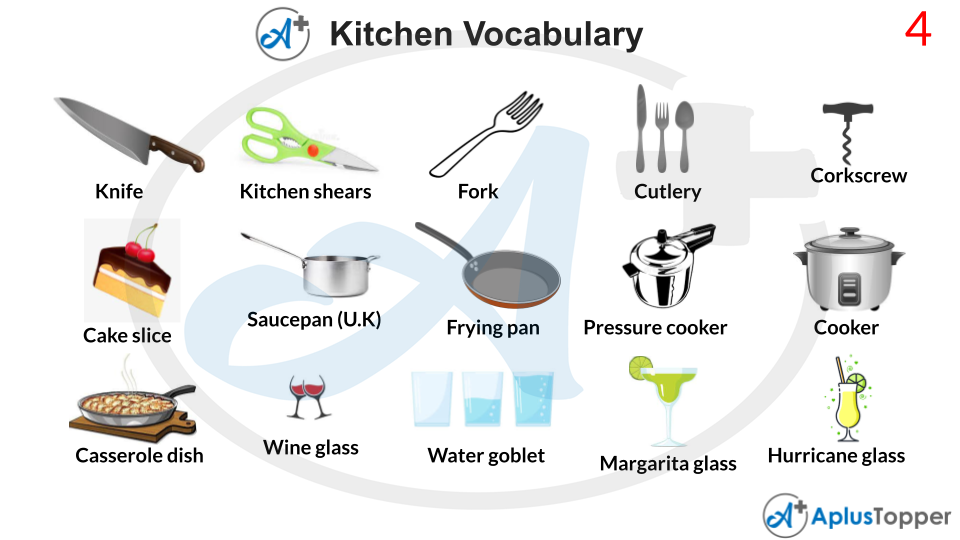Whether you’re just getting started in the kitchen or you want to brush up on some culinary terms, we’ve got you covered! Our A to Z Kitchen Items List with Pictures will give you all the cooking words and definitions that need to learn for success in the kitchen.
This list is comprehensive, so even expert chefs can feel assured they already know every term listed; but no matter your level of cooking experience, it never hurts to refresh yourself about all of these most basic yet essential ingredients and tools.
So grab your apron, turn on the oven, and get ready for an informative look at helpful pictures and succinct definitions from A-Z that are sure to help boost confidence while whipping up delicious creations!
Kitchen Vocabulary
Here is the List of Most Popular Kitchen Vocabulary Words With Their Pictures In English:
| A | Apron | 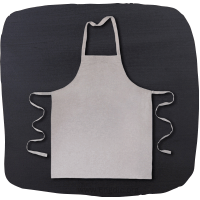
|
| B | Blender | 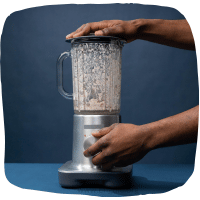 |
| C | Chef’s knife |  |
| D | Dishtowel | 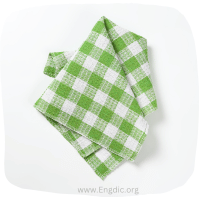 |
| E | Egg Slicer | 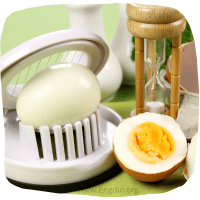 |
| F | Forks | 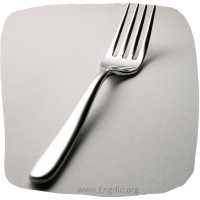 |
| G | Grater | 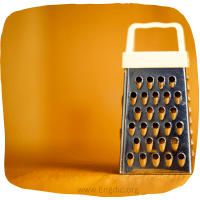 |
| H | Hand mixer | 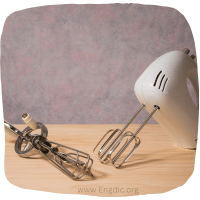 |
| I | Ice maker | 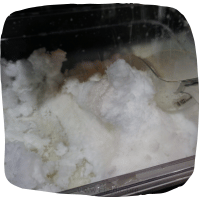 |
| J | Jug | 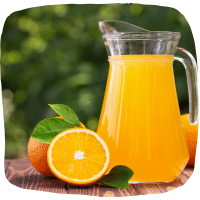 |
| K | Kitchen scale | 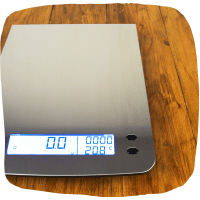 |
| L | Ladle |  |
| M | Measuring cups | 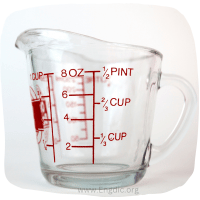 |
| N | Nutcracker | 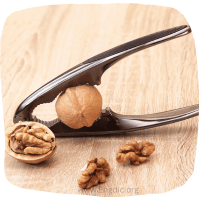 |
| O | Oven | 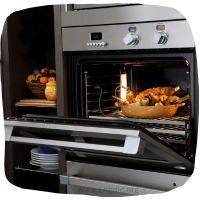 |
| P | Peeler | 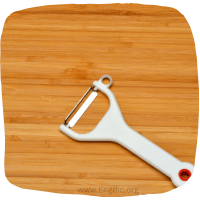 |
| Q | Quiche dish | 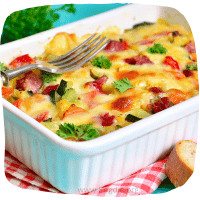 |
| R | Rolling pin | 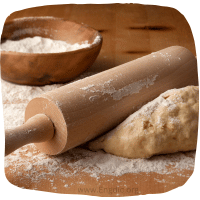 |
| S | Skillet |  |
| T | Toaster | 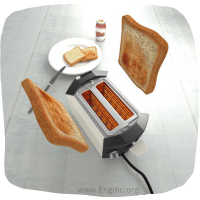 |
| U | Utensils | 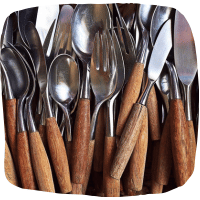 |
| V | Vegetable peeler | 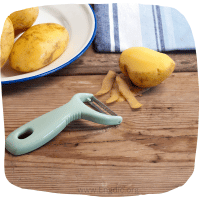 |
| W | Wok | 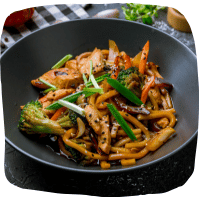 |
| X | Xanthan gum | 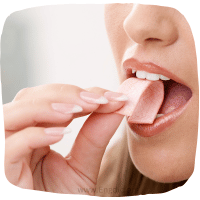 |
| Y | Yogurt maker | 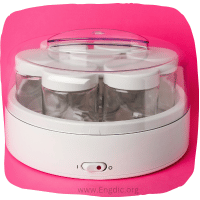 |
| Z | Zester | 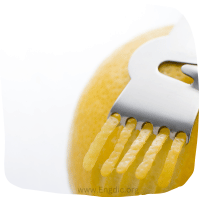 |
Discover More:
Kitchen Utensils Names List.
Glassware Names List
Kitchen Vocabulary Words List
Here is a Huge List of All Kitchen & Cooking Vocabulary words;
- Apple corer
- Apron
- Avocado slicer
- Bag clip
- Bakeware
- Baking sheet
- Banana slicer
- Barbecue brush
- BBQ fork
- BBQ glove
- BBQ sauce brush
- Beverage dispenser
- Blender
- Blender bottle
- Bottle opener
- Bread box
- Bread cutter
- Bread knife
- Bread maker
- Broiler pan
- Butcher block
- Butter dish
- Butter knife
- Cake decorating set
- Cake pan
- Cake stand
- Can opener
- Canister
- Carving board
- Carving knife
- Casserole dish
- Cast iron skillet
- Cheese board
- Cheese cloth
- Cheese grater
- Cheese slicer
- Chef’s apron
- Chef’s hat
- Chef’s knife
- Chef’s uniform
- Cherry pitter
- Chopping board
- Citrus juicer
- Citrus zester
- Cleaver
- Cocktail shaker
- Coffee grinder
- Coffee maker
- Colander
- Colander scoop
- Cold brew coffee maker
- Condiment dispenser
- Cookie cutter
- Cookie sheet
- Cooking pot
- Cooking spoon
- Cookware set
- Cooling rack
- Corkscrew
- Corn peeler
- Counter
- Countertop oven
- Cream whipper
- Crepe pan
- Crockpot
- Cupcake pan
- Cupcake stand
- Cutting board
- Cutting shears
- Deep dish pie pan
- Deep fryer
- Defrost tray
- Degreaser
- Digital scale
- Dish brush
- Dish rack
- Dish towel
- Dishwasher
- Dough blender
- Dough hook
- Doughnut pan
- Drink dispenser
- Dutch oven
- Egg beater
- Egg poacher
- Egg timer
- Electric can opener
- Electric grill
- Electric kettle
- Electric mixer
- Empanada press
- Enamelware
- End grain cutting board
- Espresso cup
- Espresso maker
- Flatware
- Flour sack towel
- Flour sifter
- Fondue set
- Food chopper
- Food mill
- Food processor
- Food scale
- Food storage container
- Freezer
- French press
- Fruit bowl
- Fruit corer
- Fruit peeler
- Frying pan
- Frying thermometer
- Garlic chopper
- Garlic press
- Glass measuring cup
- Gravy boat
- Gravy separator
- Griddle
- Grill brush
- Grill mat
- Grill pan
- Grill scraper
- Grilling basket
- Hand blender
- Hand mixer
- Handheld citrus juicer
- Handheld mixer
- Herb chopper
- Herb infuser
- Honey dipper
- Hot dog roller
- Hot pad
- Ice bucket
- Ice cream maker
- Ice cream scoop
- Ice cube tray
- Ice pop molds
- Icing spatula
- Immersion blender
- Instant pot
- Jam maker
- Jar opener
- Jerky gun
- Jigger
- Juicer
- Kitchen cart
- Kitchen island
- Kitchen scissors
- Kitchen timer
- Kitchen torch
- Knife block
- Knife sharpener
- Knife steel
- Ladle
- Lemon reamer
- Lemon squeezer
- Lid
- Lime juicer
- Lobster cracker
- Long-handled spoon
- Mandolin slicer
- Mandoline
- Measuring cups
- Measuring jug
- Measuring spoons
- Meat cleaver
- Meat grinder
- Meat hammer
- Meat thermometer
- Melon baller
- Microplane grater
- Microwave
- Milk frother
- Misto oil sprayer
- Mixing bowl
- Moka pot
- Mortar and pestle
- Mortar and pestle set
- Muffin scoop
- Muffin tin
- Non-stick frying pan
- Non-stick skillet
- Nutcracker
- Nutmeg grater
- Oil and vinegar dispenser
- Oil dispenser
- Omelette pan
- Onion chopper
- Onion goggles
- Orange juicer
- Oven
- Oven mitt
- Oven thermometer
- Pancake dispenser
- Pancake griddle
- Pancake pan
- Paper towel holder
- Pasta fork
- Pasta maker
- Pastry bag
- Pastry blender
- Pastry brush
- Pastry cutter
- Pastry mat
- Pastry tip
- Pastry wheel
- Pecan cracker
- Peeler
- Pepper grinder
- Pepper mill
- Pineapple corer
- Pizza cutter
- Pizza oven
- Pizza pan
- Pizza peel
- Pizza stone
- Plate holder
- Popcorn maker
- Popsicle molds
- Pot holder
- Pot scrubber
- Potato masher
- Poultry shears
- Pressure canner
- Pressure cooker
- Pudding mold
- Punch bowl
- Ramekin
- Ravioli stamp
- Recipe box
- Refrigerator
- Rice cooker
- Rice paddle 272
- Roasting pan
- Rolling pastry cutter
- Rolling pin
- Rotary grater
- Salad chopper
- Salad dressing shaker
- Salad hands
- Salad spinner
- Salt and pepper shakers
- Salt cellar
- Salt pig
- Sandwich cutter
- Sandwich maker
- Sausage stuffer
- Saute pan
- Scale
- Scale bowl
- Scalloped cake ring
- Scissors
- Scoop colander
- Serving dish
- Serving spoon
- Sharpening steel
- Sharpening stone
- Shears
- Silicone baking mat
- Silicone brush
- Silicone mitts
- Silicone spatula
- Silicone trivet
- Silicone whisk
- Skewers
- Skillet
- Slotted spatula
- Slotted spoon
- Slow cooker
- Slow cooker liner
- Smoker box
- Soap dispenser
- Soup ladle
- Soup pot
- Soup tureen
- Spaghetti server
- Spatula
- Spatula spoon
- Spice grinder
- Spice rack
- Splatter screen
- Spoon rest
- Spoon strainer
- Steak knife
- Steamer basket
- Stemless wine glass
- Stock pot
- Stovetop espresso maker
- Strainer
- Sugar bowl
- Sugar dispenser
- Sugar tongs
- Sushi maker
- Swiss peeler
- Taco shell maker
- Tagine
- Tea infuser
- Tea kettle
- Tea pot
- Tea spoon
- Tea strainer
- Terrine
- Thermometer fork
- Toast rack
- Toaster
- Toaster oven
- Tomato slicer
- Tongs
- Torte pan
- Tortilla press
- Trivet
- Truffle slicer
- Turkey baster
- Turkey lifter
- Two-tier steamer
- Utensil crock
- Vacuum sealer
- Vegetable brush
- Vegetable dicer
- Vegetable peeler
- Vegetable spiralizer
- Veggie peeler
- Waffle cone maker
- Waffle iron
- Water bottle
- Water dispenser
- Water filter
- Whipped cream dispenser
- Whipped cream maker
- Whisk broom
- Wine aerator
- Wine bottle holder
- Wine chiller
- Wine decanter
- Wine glass charms
- Wine opener
- Wine pourer
- Wine rack
- Winged corkscrew
- Wok
- Wood spoon
- Wooden spoon set
- Yogurt maker
- Y-shaped vegetable peeler
- Zester
- Zucchini noodle maker
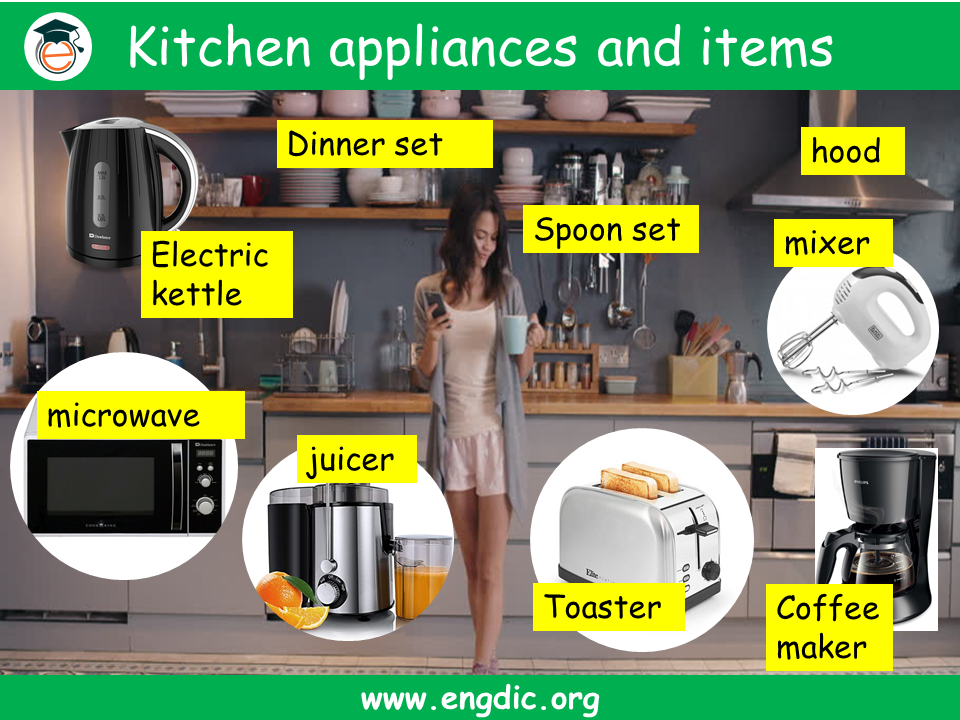
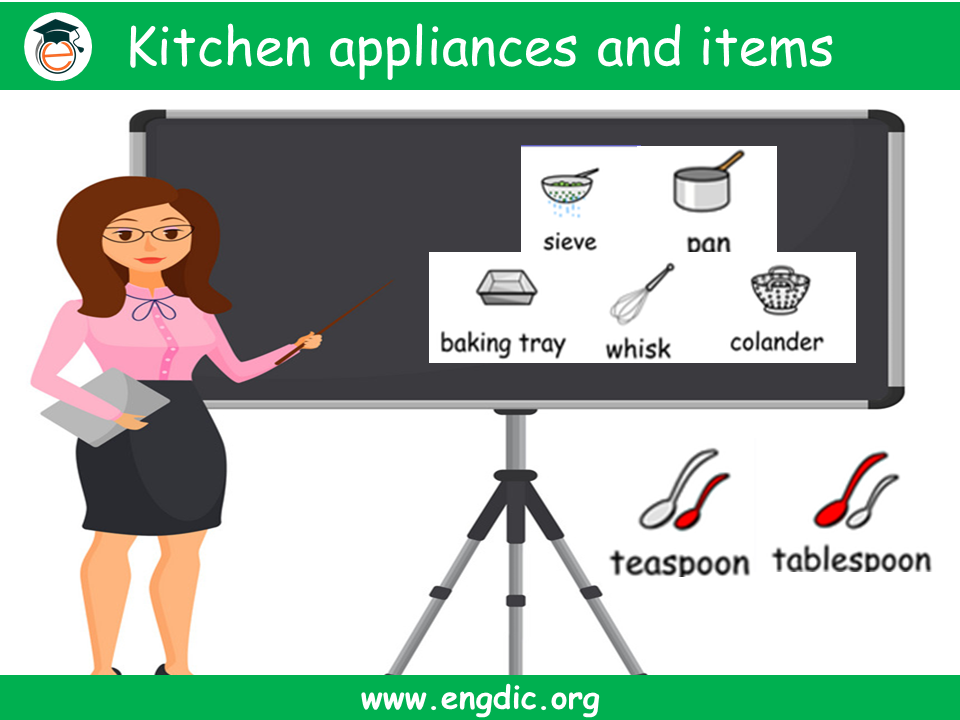
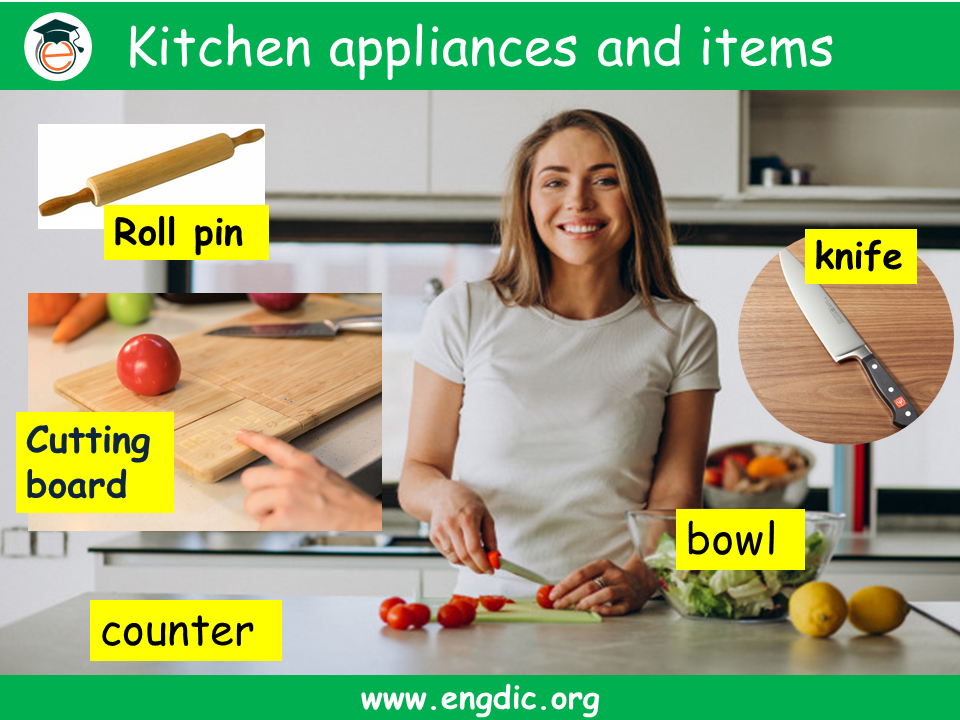
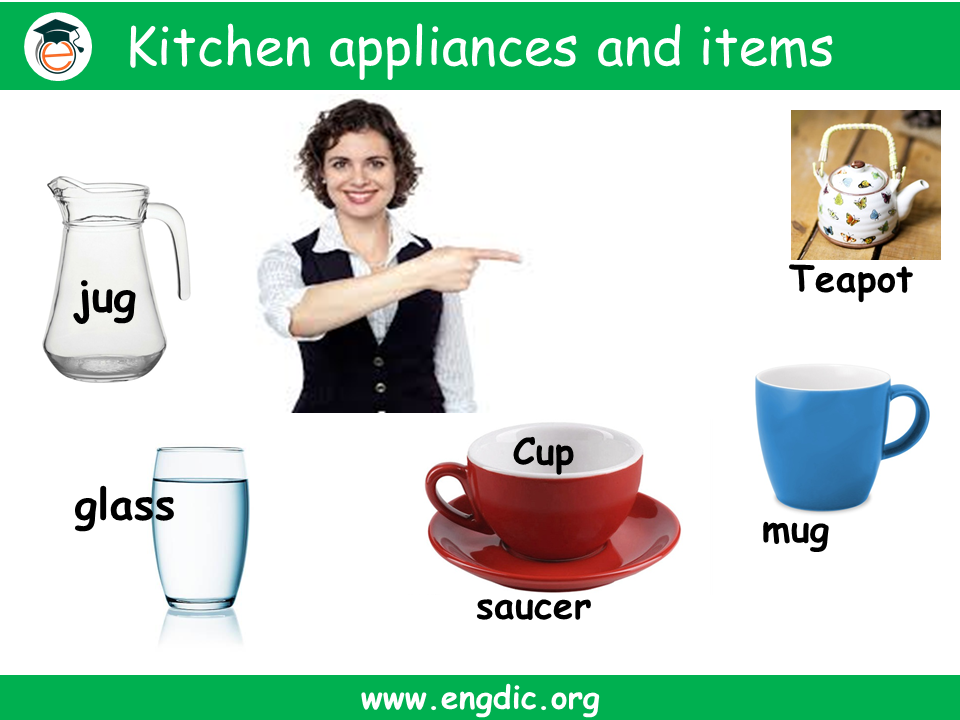
Important Kitchen Vocabulary PDF
Download Pdf Book
Speak the Food Language: A Guide to Kitchen Vocabulary for English Learners
8 min
Created: March 20th, 2023Last updated: April 12th, 2023
Contents
If you still think that English vocabulary for the kitchen is only necessary for culinary professionals, let us prove you wrong! You will be surprised by how many culinary terms and phrases you use in daily conversations (often outside the kitchen). Today’s article provides you with the most exciting words and expressions. So please, make yourself comfortable – the dinner is served.
Basic Vocabulary For Kitchen
Before diving into the thrilling world of English grammar, we need to prepare ourselves for this exciting journey. And the first thing we can do is to find out the main categories of the kitchen equipment names. Therefore, here is the list of general terms to get started with.
- Kitchen utensils – tools and implements people use to prepare food. Usually, they come in different shapes and sizes. The best examples of kitchen utensils are knives, forks, whisks, etc.
- Kitchen appliances – electrical devices people use for different cooking processes, such as baking, cleaning, etc. This category includes refrigerators, ovens, dishwashers, and more.
- Ingredients – raw materials people use to make food.
- Recipe – a set of instructions you can use for preparing a dish. Typically, it includes a list of ingredients, measurements, and essential steps.
- Cooking methods – different techniques and processes we use to prepare food.
These are just some common examples of in-the-kitchen vocabulary. Of course, there are many more words than you can think of. And this is what we precisely are planning to discuss next. So, now that you know the basics, we are pleased to say – welcome to our vocabulary and grammar kitchen!
Kitchen Appliance Names in English
Even though our ancestors used to prepare their food on the sole fire, the world has changed. Today, we can’t imagine our lives without useful technologies that significantly simplify our lives and make our cooking more pleasant. Hence, to honor all the inventions of the past and present centuries, we’ve decided to start with a list of the electronic things in a kitchen.
- Refrigerator – a kitchen appliance used for storing goods and drinks at low temperatures.
- Stove – a common kitchen appliance that uses gas or electricity to generate heat for cooking food; typically consists of a cooktop with burners and an oven for baking and roasting.
- Oven – a gas- or electricity-powered appliance used for cooking food with dry heat.
- Microwave oven – a kitchen supply we use for heating meals.
- Dishwasher – an appliance used for automatically washing dishes.
- Blender – a kitchenware for blending, mixing, or puréeing ingredients, primarily used for making smoothies, soups, sauces, etc.
These are the appliances you can find in almost every kitchen in the world. Of course, we can’t speak for every person, but for us, they are irreplaceable. But, of course, that is not all! There are much more electronic supplies you can use for making your food. Hence, let’s find some more helpful kitchen stuff name examples.
6
Kitchen Objects in English
Culinary terms might be confusing even for native speakers. But don’t worry – there is no need to be Gordon Ramsay to master English kitchen vocabulary. With the following compilations of cooking terms, you will be almost ready to become a new MasterChef. So, let’s look at what we’ve prepared for you without further ado.
Utensils
In general, kitchen utensils include everything you can use for preparing, serving, and eating food. No particular classification can explain what is considered a utensil and what’s not. Therefore, here are the most popular tools that are suitable for this category.
- Plate – a flat dish for serving and eating food.
- Bowl – a deep container for mixing, serving, and eating food.
- Fork – a kitchen utensil with tines.
- Spoon – a tool with a shallow round end used for eating liquid food, e.g., soups.
- Knife – a sharp utensil for cutting products.
- Glass – a deep cylindrical container for pouring and drinking liquids.
- Mug – a large cup with a handle.
- Pot – a deep container with a lid for cooking meals on a stove.
- Cutting board – a small surface for cutting and chopping food on it.
- Pan – a shallow, flat-bottomed container for frying food on a stove.
With these kitchen utensils you can cook almost any meal you can imagine. But you can’t make food out of the air, right? So, in addition to the valuable utensils, you also need some tasty ingredients. Let’s talk about them next.
Types of Ingredients
Of course, we will not name every single food item that has ever existed. Instead, we will provide you with the most common categories you can use to cook delicious food. Here are some common types of ingredients in English:
- Fruits and vegetables – edible plant-based foods like apples, carrots, lettuce, etc.
- Meats and poultry – animal-based foods like pork, chicken, or beef.
- Seafood – aquatic-based foods like shrimp, tuna, and salmon.
- Grains – edible seeds from cereal crops, like rice or quinoa.
- Dairy – milk-based products like cheese, yogurt, or sour cream.
- Herbs and spices – flavorful plant-based ingredients used to add taste to the meal, like paprika, garlic, or basil.
- Oils and fats – ingredients used for cooking, like butter, olive, and coconut oil.
- Sweeteners – ingredients used to make dishes sweet, including sugar, maple syrup, and honey.
Yum! Now we have enough food and utensils to make something unique. But there is still one problem – we don’t know the differences between various cooking technologies. So let’s solve it together and check out the cooking methods suitable for every kitchen.
Cooking Methods
Even though some ingredients can be totally edible while raw, most cooking materials should be prepared in a specific method. Below is the list of the most common culinary techniques to try out in your kitchen.
- Boiling – preparing food in a liquid that has reached its boiling point, e.g., boiling eggs.
- Simmering – preparing food in a liquid below its boiling point, e.g., simmering soup.
- Roasting – making a meal using dry heat in the oven, e.g., roasting chicken.
- Baking – making a meal surrounded by hot air in the oven, e.g., baking a pie.
- Frying – cooking food in hot oil, e.g., frying donuts.
- Sautéing – cooking food quickly in a hot pan with oil.
- Steaming – cooking food by exposing it to steam from boiling water.
Well done! Now you know enough kitchen vocabulary to master the art of cooking. These simple terms allow you to use most English recipes and make delicious meals. And if you want even more cooking and language-learning experience, don’t forget to check our next topic.
Best TV Programs to Practice Kitchen English Vocabulary
Culinary programs are one of the most popular kinds of television shows right now. Unfortunately, there are so many of them that it is challenging to choose the best. But don’t worry. We’ve done the hard work for you! And we are excited to share our personal top three kitchen-related TV shows suitable for English learners.
- MasterChef. It is one of the most popular cooking shows that feature amateur and professional chefs competing in various culinary challenges. There you’ll hear a lot of cooking terminology and get exposure to a wide variety of ingredients names. There are many adaptations of this program around the globe, but our favorite versions are the American and British ones.
- Jamie Oliver’s Food Revolution. In this show, celebrity chef Jamie Oliver travels around the world promoting healthy eating habits and teaching people how to cook. You’ll learn about healthy cooking and eating habits, as well as find out various cooking terms and techniques.
- Food Network. It is not a program but a whole channel dedicated to all things food and cooking. You can watch shows like “Chopped,” “Iron Chef America,” and “Good Eats” to learn more culinary vocabulary.
All these channels and shows are a great way to practice and learn something new for those who want to expand their culinary knowledge and English skills at the same time. And what is your favorite cooking program? Let us know in the comments!
Install the Promova App to Learn Dozens of Kitchen Words
The key to achieving any goal is persistence. The more time you spend practicing, the better the results will be. And it doesn’t matter whether you want to learn a new recipe or language. The point is to find the most suitable option for yourself and keep moving forward.
If you want to learn new culinary terms in English, we know the best solution! Don’t walk, but run to the App Store or Google Play and install the user-friendly Promova application. After passing a quick test, you will access unique studying materials based on your proficiency level and learning preferences. In addition, you can find dozens of lessons dedicated to kitchen terms, from food to kitchen furniture names. And the best thing is that you can use the application for free.
And that is not all! On both the official Promova website and application, you can join personal or group lessons with our professional tutors. If you are still hesitating about it, you can access a free trial lesson to get acquainted with the main processes and make the final decision. For those who aim to practice speaking, we offer a free Conversation Club where you can discuss various topics with people from different countries. To sum up, there are a lot of features to choose from. Go to our website, and pick the perfect one for you!
Conclusion
Honestly, we are starving after writing this article. So to sum it up, kitchen vocabulary can be fascinating if you know how to make studying enjoyable. We hope that you find this topic useful. And we are excited to see your favorite recipes in the comments section! So please don’t be shy and tell us about them using new vocabulary.
FAQ
Will I mess up my recipe if I don’t understand some kitchen vocabulary in English?
Well, it depends on many factors. If you are familiar with the meal you prepare, you might know which ingredients and cooking techniques to use. But if it is your first time, and you see many unknown terms, there is a high risk of doing something wrong. That is why we recommend learning new words before making your dinner.
What does “the icing on the cake” idiom mean?
This kitchen-related idiom often describes a situation where something good or positive has already occurred. Then another positive thing happens, which makes the situation even better or more enjoyable. It’s like adding a layer of sweet icing to an already delicious cake.
Are there any tips for memorizing difficult kitchen words?
Like with any other complicated terms, some tips can be helpful. For example, you can use vocalization methods – try to say aloud every new word you learn while preparing a meal in your kitchen. It will help you memorize it and also bring an excellent bonus in the form of increasing your cooking skills.
What are some standard cooking terms that can be confusing for non-native English speakers?
Some of the most common and confusing cooking terms include words like simmer, sauté, and braise. The reason is simple – such words are usually borrowed from foreign languages and are primarily used in professional kitchens. So unprepared English learners might be surprised after seeing them in a regular recipe.
Кухня — это целая вселенная. Чего здесь только нет: и столовые приборы, и посуда, и различная утварь для приготовления еды, в том числе электроприборы. В этой статье мы собрали максимум лексики по этой теме — здесь вы найдёте всё, что есть на кухне. Транскрипция к каждому слову поможет понять, как его произносить.
Слова разделены по категориям. Воспользуйтесь оглавлением, чтобы найти нужный раздел.
Столовые приборы
cutlery [‘kʌtl(ə)rɪ] — столовые приборы
spoon [spuːn] — ложка
tablespoon [‘teɪblspuːn] — столовая ложка
teaspoon [‘tiːspuːn] — чайная ложка
wooden spoon [wʊdn spuːn] — деревянная ложка
fork [fɔːk] — вилка
knife [naɪf] — нож
butter knife — нож для масла
Посуда
glass [glɑːs] — стакан
mug [mʌɡ] — кружка
cup [kʌp] — чашка
saucer [‘sɔːsə] — блюдце
plate [pleɪt] — тарелка
bowl [bəul] — миска, чаша
plastic bowl — пластиковая миска
glass bowl — стеклянная миска
steel bowl — стальная миска
pot [pɒt] — кастрюля
pan [pæn] — сотейник
frying pan [fraɪɪŋ pæn] — сковорода
casserole dish — блюдо для запекания
baking sheet [ˈbeɪkɪŋ ʃiːt] — лист для выпечки
kettle [‘ketl] — чайник
teapot [‘tiːpɔt] — чайник (для заварки)
electric kettle — электрический чайник
pitcher [pɪtʃə] — кувшин (jug [dʒʌɡ])
Читайте также: Еда и напитки на английском
Кухонная утварь
kitchen utensils — кухонная утварь
peeler [‘piːlə] — овощечистка
grater [‘greɪtə] — тёрка
garlic press [ˈɡɑːlɪk pres] — пресс для чеснока
potato masher [pəˈteɪtəʊ mæʃə(r)] — толкушка
whisk [(h)wɪsk] — венчик
spatula [‘spætjulə] — лопатка
sieve [sɪv] — сито
ladle [‘leɪdl] — половник
tongs [tɔŋz] — щипцы
knife sharpener — точилка для ножей
tin opener [ˈtɪn əʊpənə(r)] — консервный нож (can opener [ˈkæn əʊpənə(r)])
corkscrew [‘kɔːkskruː] — штопор
colander [‘kʌləndə] — дуршлаг
mixer [ˈmɪksə(r)] — миксер
rolling pin [ˈrəʊlɪŋ pɪn] — скалка
chopping board [ˈtʃɒpɪŋ bɔːd] — разделочная доска (амер. cutting board [ˈkʌtɪŋ bɔːd])
food storage container — контейнер для еды
jar — банка
salt cellar [sɔːlt selə(r)] — шейкер для соли (амер. salt shaker [sɔːlt ʃeɪkər])
pepper pot [pepə pɒt] — шейкер для перца (амер. pepper shaker [ˈpepə ʃeɪkə])
pepper mill [ˈpepə mɪl] — мельница для перца
measuring cup [ˈmeʒərɪŋ kʌp] — мерная кружка
funnel [ˈfʌnl] — воронка
ice cube tray — форма для льда
aluminum foil — алюминиевая фольга
scales — весы
apron [‘eɪpr(ə)n] — фартук
oven glove — прихватка (oven mitt)
Читайте также: Лексика по теме «Дом» на английском
Кухонное оборудование
microwave [‘maɪkrə(u)weɪv] — микроволновая печь
toaster [təʊstə(r)] — тостер
waffle maker — вафельница
multicooker [mʌltiˌkʊkə(r)] — мультиварка
deep fryer — фритюрница
steamer [stiːmə(r)] — пароварка
food processor [fuːd ˌprəʊsesə(r)] — кухонный комбайн
coffee maker [kɒfi meɪkə(r)] — кофеварка
juicer [dʒuːsə(r)] — соковыжималка
mincer [mɪnsə(r)] — мясорубка (амер. meat grinder [miːt ɡraɪndər])
blender [ˈblendə(r)] — блендер
hand blender — ручной блендер
refrigerator [rɪˈfrɪdʒəreɪtə(r)] — холодильник (fridge [frɪdʒ])
freezer [friːzə(r)] — морозилка (deep freeze [diːp friːz])
cooker [ˈkʊkə(r)] — плита (амер. stove/range [stəʊv]/[reɪndʒ])
electric stove/range/cooker — электрическая плита
gas stove/range/cooker — газовая плита
burner [ˈbɜːnə(r)] — конфорка
cooktop — варочная поверхность
oven [ˈʌvn] — духовка
cooker hood — вытяжка (амер. range hood/stove hood)
grill [ɡrɪl] — гриль
dishwasher [ˈdɪʃwɒʃər] — посудомоечная машина
sink [sɪŋk] — раковина
Визуальный словарь с произношением
Посмотрите видео по теме — там те же слова, только с произношением и картинками.
Kitchen Vocabulary: This document is dedicated to things in kitchen vocabulary or a list of culinary terminology terms illustrated with photographs. It doesn’t matter where one comes from in the world or what language one speaks; food is one thing that will always bring people together.
Food is quite important in English-speaking nations, and if you find yourself in the position of having to cook with an English-speaking acquaintance, you will need to be familiar with the names of the many ingredients that can be found in the kitchen. To help one get started, we’ve put up a hand-picked list of kitchen appliances and gadgets vocabulary just for you.
- Name of Kitchen Appliances and Gadgets Vocabulary words
- Description of the Kitchen Appliances and Gadgets Vocabulary words.
Name of Kitchen Appliances and Gadgets Vocabulary words
Cooking and food preparation takes place in the kitchen, which may be found in either a residential or commercial facility. When it comes to kitchen equipment and utensils such as a toaster, refrigerator, cabinet, closet, dining table, etc., there are many different varieties to choose from, and one needs to be familiar with atleast five things in kitchen.
Knowing these terms will not only help you speak more effectively, but it will also be incredibly beneficial while following recipes, whether they are on video or in writing. Throughout this part, you will learn how to properly reference the many objects that may be found in a kitchen setting and learn words related to kitchen appliances and gadgets.
List of Kitchen Appliances & Gadgets
- Toaster
- Kettle
- Mixer
- Refrigerator
- Blender
- Cabinet
- Cupboard
- Cooker hood (U.K) – range hood (U.S)
- Microwave
- Dish soap
- Kitchen counter
- Dinner table
- Kitchen scale
- Pedal bin
- Grill
- Drawer
- Apron
- Breadbasket
- Bowl
- Teapot
- Measuring cup
- Baking tray
- Timer
- Spice container
- Chopping board
- Grater
- Pie plate
- Salad spinner
- Colander
- Butter dish
- Oven glove
- Napkin
- Chopsticks
- Rolling pin
- Measuring spoon
- Whisk
- Wooden spoon
- Strainer
- Steak hammer
- Spoon
- Spatula
- Mesh skimmer
- Cleaver
- Ladle
- Knife
- Kitchen shears
- Fork
- Cutlery
- Corkscrew
- Cake slice
- Saucepan (U.K) – pot (U.S)
- Frying pan
- Pressure cooker
- Cooker
- Casserole dish
- Wine glass
- Water goblet
- Margarita glass
- Hurricane glass
- Champagne flute
- Cocktail glass
- Irish coffee glass
- Cognac balloon
- Plastic cup
- Mug
- Beer mug
- Weizen glass
- Teacup
- Demitasse
- Footed pilsner glass
- Collins glass
- Vodka glass
- Shot glass
- Dessert fork
- Teaspoon
- White wine glass
- Red wine glass
- Water goblet
- Bread and butter knife
- Coffee cup
- Saucer
- Bread and butter plate
- Napkin
- Salad fork
- Dinner fork
- Dinner plate
- Dinner knife
- Salad knife
- Chef’s knife
- Can Opener
- Tea Maker
- Mixing Bowl
- Vegetable Peeler
- Potato Masher
- Citrus Juicer
- Garlic Press
- Paring Knife
- Bread knife
- Honing Steel
- Knife Sharpener
- Kitchen Stove
- Kitchen Tongs
Description of the Kitchen Appliances And Gadgets Vocabulary Words
Toaster
An electric toaster is a tiny electric gadget that is meant to expose various types of sliced bread to radiant heat, browning the bread and transforming it into toast. Bread is put into a slot on the top of the toaster from one end of a single vertical slice. Pressing down on the toaster’s side causes the bread to be lowered into the toaster and the heating components to be activated, as shown in the video.
Kettle
A kettle, also known as a tea kettle or teakettle, is a sort of pot that is specifically designed for boiling water. It is often equipped with a lid, spout, and handle, although it can also be a tiny electric kitchen appliance of similar form that is self-contained in its operation.
Mixer
It is also known as a hand mixer or stand mixer, depending on the model, and it is a kitchen appliance that utilises a mechanism that is gear-driven to rotate a set of “beaters” in a container containing the liquids or food that are to be prepared by mixing them. Mixers aid in the automation of repetitive operations such as stirring, whisking, and beating.
Refrigerator
A refrigerator is one of our most significant domestic appliances, and it serves several functions. In order to keep food and beverages cold, it forces a liquid refrigerant through a sealed system, causing it to evaporate and draw heat from the refrigerator. After that, the vaporised refrigerant is routed via coils outside the refrigerator to cool it (at the back or the bottom).
Blender
Food and other things are blended in a blender, which is a kitchen and laboratory equipment used to mix, crush, purée, or emulsify food and other substances. A stationary blender is made up of a blender container with a spinning metal blade at the bottom that is driven by an electric motor located in the base of the blender.
Cabinet
Kitchen cabinets are built-in pieces of furniture that are installed in many kitchens to provide storage for food, cooking equipment, and, in certain cases, cutlery and plates for serving at the table. Cabinetry in the kitchen is frequently designed to accommodate appliances such as refrigerators, dishwashers, and ovens.
Cupboard
To designate an open-shelved side table for exhibiting dishware, especially plates, cups, and saucers, the term cupboard was used in the early twentieth century. These open cupboards generally contained between one and three display layers, as well as a drawer or a series of drawers, depending on the historical period.
Cooker hood (U.K) – range hood (U.S)
Kitchen hoods are a type of ventilation equipment that hangs over the stove or cooktop in the kitchen. They are also referred to as exhaust fans and range hoods. It eliminates airborne grease, combustion products, odours, smoke, heat, and steam from the air by the use of a combination of air evacuation and filtration techniques.
Microwave
A microwave is a kind of electromagnetic radiation with wavelengths ranging from about one metre to one millimetre, which correspond to frequencies between 300 MHz and 300 GHz, respectively. Microwaves are used in telecommunications and other applications. Different sources define microwaves as operating at different frequency ranges; the wide definition provided above encompasses both the UHF and EHF bands.
Dish soap
In the dishwashing industry, dishwashing liquid is referred to by several names, including dishwashing soap, dish detergent, and dish soap, among others. It is often a highly foamy combination of surfactants that causes little skin irritation, and it is generally used for hand cleaning dishes such as glasses, plates, cutlery, and cooking utensils in a sink or mixing bowl.
Kitchen counter
A countertop, also known as a counter, benchtop, worktop, or kitchen bench, is the horizontal surface of a counter that is solid, flat, and horizontal in shape. They are designed for use in kitchens or other food preparation facilities, restrooms or toilets, and general workrooms and warehouses, among other places.
Dinner table
The dining table is where supper is served and consumed in most households. Table for serving meals; “he assisted her in clearing the dinner table”; “a feast was laid out on the board” leaf – hinged or detachable flat piece; “he helped her clear the dining table” (as of a table or door).
Kitchen scale
A kitchen gadget is used to measure the weight of ingredients and other culinary items in the kitchen. Kitchen scales are offered in two types: balancing models and spring models. The use of a scale will result in a more precise measurement of the components than the use of a volumetric measuring cup.
Pedal bin
A pedal bin is a garbage container that is typically seen in a kitchen or bathroom. This container has a lid that is operated by pressing a pedal on the floor with your foot.
Grill
Grilling is a process or method of cooking that involves the application of dry heat to the surface of food, most frequently from above, below, or to the side of the meal. Grilling is characterised by the use of a considerable quantity of direct, radiant heat and the rapid cooking of meat and vegetables on a grill.
Drawer
A drawer is a container that holds things. DROR is a box-shaped container that is designed to fit horizontally inside a piece of furniture, allowing for the storage and retrieval of a variety of items. Numerous different types of furniture, such as cabinets, chests of drawers, desks, and other similar items, are equipped with drawers.
Apron
An apron is originally a garment that is worn over other clothes and that covers the majority of the body’s frontal areas. The term “apron” derives from an old French word that originally meant a tiny piece of fabric; however, through time, “a napron” became “an apron,” a process known as rebracketing in linguistics, which is a process in which words are changed from one to another.
Breadbasket
A bread basket may be used for a variety of tasks in the kitchen. Besides serving bread at the breakfast table, it is also useful for storing fruits, vegetables, and snacks – or for keeping items in the order in a kitchen cabinet.
Bowl
A bowl is a circular dish or container that is generally used for food preparation and serving. It is typical of bowls that their interiors have the shape of cylindrical caps, with the sides and bottom creating one continuous curve. Because of this, bowls are particularly well adapted for storing liquids and loose food, as the contents of the bowl are commonly gathered in the bowl’s centre due to the gravitational pull of the bowl.
Teapot
When steeping tea leaves or a herbal combination in boiling or near-boiling water, a teapot is used to serve the resultant infusion, which is known as tea, to the customer. It is acknowledged to be one of the most important components of teaware. On the top of the teapot, there is generally an aperture with a cover, through which the dried tea and hot water are added, a handle for holding the teapot in one hand.
Measuring cup
It is generally used to measure the volume of liquid or bulk solid culinary materials such as flour and sugar, with quantities ranging from around 50 mL to several gallons or gallons. When it comes to laundry, measuring cups are also useful for weighing out washing powder, liquid detergents, and bleach for use in the washing machine.
Baking tray
Oven-safe sheet pans are rectangular metal pans that are flat and rectangular in shape that are used in the oven. Baking bread rolls, pastries, and flat goods like cookies, sheet cakes, swiss rolls and pizzas are some of the most well-known uses for this product.
Timer
A timer is a sort of clock that is specifically designed for monitoring certain time periods. Generally speaking, timers may be divided into two categories. In the context of measuring elapsed time, a stopwatch is commonly used, whereas a timer is more commonly used to refer to a device that counts down from a predetermined time period.
Spice container
An organising gadget that is used to hold bottles of seasonings and spices, a spice rack is a useful piece of furniture. Spice racks are available in a wide range of materials, sizes, and designs to suit your needs. A spice rack is used to keep bottles of spices and seasonings organised and easy to find. A spice rack can also refer to a unit that can be lifted out of a pantry shelf, as in the case of a spice rack.
Chopping board
A cutting board is a sturdy piece of wood on which to layout material to be cut into pieces. Kitchen cutting boards are most often used in the preparation of food; however, different types of cutting boards are available for cutting raw materials such as leather or plastic. Kitchen cutting boards are typically constructed of wood or plastic, and they are available in a variety of widths and lengths.
Grater
Grators are kitchen tools with a rough surface that are used to chop food into extremely small pieces. Grators are available in various sizes and shapes. Grating machines are available in a number of shapes and sizes, and they may be used to prepare a vast range of foods, including cheese and vegetables. In addition to grating cheese and lemon or orange peel (to generate zest), they may also be used to shred other soft foods such as potatoes and carrots.
Pie plate
Pie plates are 1 to 1 1/2 inch deep circular baking dishes with shallow sloping edges and a diameter of 12 to 14 inches. Pie plates are used for both single-crust and double-crust pies baked in the oven. Also available are deep-dish varieties with slanted sides that are 2 to 2 1/2 inches deep and vary in diameter from 9 to 11 inches, as well as shallow-dish varieties.
Salad spinner
In the kitchen, a salad spinner, sometimes known as a salad tosser, is a culinary instrument that is used to wash and remove extra water from salad greens before serving. This device separates the water from the leaves using centrifugal force, making it possible for the salad dressing to adhere to the leaves.
Colander
A colander is a type of kitchen tool that is used to filter meals such as pasta or to rinse vegetables after they have been cooked. The perforated structure of the colander allows liquid to drain through while solids are retained inside. Using a colander is simple. It is referred to as a pasta strainer or a kitchen sieve in some circles.
Butter dish
An official definition of a butter dish is “a typically round or rectangular dish with a drainer and a cover that is used to keep butter at the table.” Prior to the invention of refrigerators, butter was kept in a covered dish made of crystal, silver, or porcelain.
Oven glove
An oven glove, also known as an oven mitt, is a type of insulated glove or mitten that is typically worn in the kitchen to conveniently protect the wearer’s hand from hot things such as ovens, stoves, cookware, and other similar objects that are extremely hot. They are similar to potholders in appearance.
Napkin
As a term denoted by its square of cloth or paper tissue used at the table to wipe the fingers and mouth while eating, a napkin is also known as a serviette or a face towelette. It is generally folded and tiny, with complex patterns and forms on the outside and inside.
Chopsticks
Chopsticks are a pair of equal-length sticks that are fashioned like chopsticks and have been used as cooking and dining utensils across much of East Asia for more than three thousand years. They are held in the dominant hand with the fingers holding them in place, and they are used as extensions of the hand to pick up little bits of food.
Rolling pin
An oblong food preparation item, a rolling pin is used to form and flatten dough during baking or cooking. Rollers and rods are the two types of rolling pins that may be encountered. Roller rolling pins are often made of a large cylinder with tiny handles at either end, whereas rod rolling pins are typically made of thin tapered batons.
Measuring spoon
When cooking, a measuring spoon is a spoon that is used to measure a certain amount of an ingredient, whether it be liquid or dry. Measuring spoons are available in a variety of materials, including plastic, metal, and others. It is completely possible to purchase them in a variety of sizes, including teaspoons and tablespoons.
Whisk
A whisk is a culinary instrument that may be used to smooth out components or to introduce air into a concoction, which is referred to as whisking or whipping in some circles. The majority of whisks are made up of a long, narrow handle with a succession of wire loops that are linked together at the end. Most of the wires are made of metal; however, others are made of plastic, which may be used with nonstick cookware. Bamboo may also be used to make whisks.
Wooden spoon
A wooden spoon is a utensil that is frequently used in the preparation of meals. Coconut or mineral oil can be used to treat wooden spoons in order to prevent them from absorbing cold liquids. It is necessary to add edible drying oils, such as hemp seed oil, walnut oil, and flax oil, to get a more lasting finish.
Strainer
A sieve, sift or fine mesh strainer is a device used to separate desired materials from undesirable material or to characterise the particle size distribution of a sample by use of a screen such as woven mesh, net, or perforated sheet material. The term “sift” is derived from the term “sieve.”
Steak hammer
A meat tenderiser, also known as a meat mallet or pounder, is a hand-powered instrument used to tenderise slabs of meat before cooking. Although a meat tenderiser may be constructed from practically any object, three kinds are designed expressly for this purpose.
Spoon
A spoon is a type of utensil that consists of a tiny shallow bowl, either oval or round, attached to a handle. A kind of cutlery, particularly when used as part of a place setting, is primarily employed for the purpose of stuffing food to the mouth. Additionally, spoons are used in food preparation to measure, mix, stir, and toss ingredients, as well as to serve meals.
Spatula
A spatula is a flat, flexible blade broad that is used to mix, distribute, and lift items such as meals, medications, plaster, and paints. In medical terminology, the term “spatula” may also refer to the tongue depressor.
Mesh skimmer
The mesh Skimming Spoon is most frequently used to remove fat and small particles from soups, stews, and cooked meats. Additionally, it is an excellent instrument for removing the foam that forms on the surface of soups or jams while cooking. A skimming spoon is also known as a skimming ladle, a skimming spoon, a skimmer, or a strainer spoon.
Cleaver
A cleaver is a big knife that varies in shape but often resembles a hatchet with a rectangular blade. It is mostly used as a kitchen or butcher knife, with the purpose of breaking big chunks of soft bone and cutting through thick amounts of meat.
Ladle
A ladle is a culinary utensil that is used to serve soup, stew, and other meals. Although designs vary, a typical ladle usually has a long handle terminating in a deep bowl, usually angled toward the handle to assist in lifting liquid from a pot or other receptacle and transferring it to a bowl.
Knife
A knife is primarily a tool or weapon that features a cutting edge or blade and is frequently equipped with a handle or hilt. Knives were one of humanity’s oldest tools, as indicated by the Oldowan tools, at least 2.5 million years ago.
Kitchen shears
Using kitchen shears (which, appropriately, are also called poultry shears) to cut through the bird’s flesh and joints is not just faster and safer than using a knife. Then, using shears, cut away any excess fat.
Fork
A fork is a cutlery or kitchenware tool with a long handle that culminates in ahead with numerous narrow and typically slightly curved tines that are used to spear meals either to hold them while cutting with a knife or to elevate them to the mouth.
Cutlery
In Western culture, cutlery refers to any hand instrument used for preparing, serving, and especially consuming food. A cutler is someone who manufactures or sells cutlery. The knife, fork, and spoon are the three primary pieces of silverware in Western civilisation.
Corkscrew
A corkscrew is a tool used to extract corks from wine bottles and other home containers that may be cork-sealed. A corkscrew in its most basic form holds a pointed metallic helix linked to a handle that the operator screws into the cork and pull to remove it.
Cake slice
A knife with a broad, triangular, unsharpened blade that is ideal for cutting and serving cake pieces.
Saucepan (U.K) – pot (U.S)
A saucepan is a large, deep stovetop pan that often has a long handle and a cover. A saucepan can be used to boil sauce or macaroni from a box of macaroni and cheese. Saucepans are manufactured from a variety of materials, including stainless steel, aluminium, copper, and enamel-coated metal.
Frying pan
A frying pan, frypan, or skillet is a shallow pan with a flat bottom that is used for frying, searing, and browning food. It is generally between 20 and 30 centimetres in diameter, with somewhat low flared sides, a long handle, and no cover. On larger pans, a small grab handle may be located opposite the main handle.
Pressure cooker
Pressure cooking is the method of cooking food under high-pressure steam in a sealed vessel called a pressure cooker, using water or a water-based cooking liquid. High-pressure cooking eliminates the need for boiling and enables temperatures much beyond 100 °C to be attained.
Cooker
A kitchen stove, also referred to as a stove or a cooker, is a kitchen device used to cook meals. Kitchen stoves rely on direct heat for cooking and may also include an oven for baking.
Casserole dish
A casserole is a type of big, deep pan or bowl that is used in the oven to prepare a range of meals; it is also a category of foods cooked in such a vessel. To differentiate between the two applications, the pan is referred to as a “casserole dish” or “casserole pan,” whilst the food is simply referred to as “a casserole.”
Wine glass
A wine glass is a special sort of glass used for drinking and tasting wine. The majority of wine glasses are stemware; that is, goblets comprised of three components: the bowl, the stem, and the foot. Red wine glasses are distinguished by a rounder, broader bowl, which accelerates the pace of oxidation.
Water goblet
Water goblets are a sort of stemware that is often used in conjunction with wine glasses or goblets informal place settings. While water goblets are typically constructed of glass or crystal, they can also be made of metal, ceramic, wood, or plastic. Consume just water in these big goblets.
Margarita glass
The Margarita glass is basically a variation of the traditional coupe glass that is often used to serve Margaritas. It has a tiny secondary bowl in the centre, which adds volume and visual appeal.
Hurricane glass
Hurricane glass is a type of drinking glass that generally holds 20 fluid ounces in the United States. It is used to serve mixed cocktails, most notably the Hurricane, which originated in New Orleans’ Pat O’Brien’s Bar.
Champagne flute
A Champagne glass is a type of stemware that is specifically intended for champagne and other sparkling wines. The flute and coupe are the two most popular stemmed glasses; holding the glass by the stem stops the liquid from overheating.
Cocktail glass
A cocktail glass is originally a stemmed glass with an inverted cone bowl that is mostly used to serve pure cocktails. Despite these small differences, the phrase cocktail glass is frequently used interchangeably with a martini glass.
Irish coffee glass
Irish coffee is basically a drink made with hot coffee, Irish whiskey, sugar, and cream. The coffee is consumed with the cream. Irish whiskey and at least one teaspoon of sugar are poured over freshly brewed black coffee and swirled until completely dissolved.
Cognac balloon
A snifter (other names include brandy snifter, brandy glass, brandy bowl, cognac glass, and balloon of Herion) is a kind of stemware with a short stem with a broad bottom and a somewhat small top. It is mostly used to serve old brown spirits like bourbon, brandy, and whisky.
Plastic cup
A plastic cup is one that is constructed of plastic. It is most frequently used as a vessel for drinks. Some are reusable, while others are designed to be used once and then recycled or disposed of. Some are transparent, while others are opaque.
Mug
A mug is a sort of cup that is generally used for hot beverages like coffee, hot chocolate, or tea. Mugs, on the other hand, often have handles and carry a greater volume of liquid than other types of cups. A mug typically holds between 240 and 350 mL of liquid.
Beer mug
Beer glassware is a term that refers to containers made of glass that are specifically designed or frequently used for serving and drinking beer. Other than glass, drinking containers for beer are fashioned of a number of materials, including earthenware, pewter, and wood.
Weizen glass
Wheat beer is served in a Weizen glass. The glass, which originated in Germany, is small at the bottom and somewhat broader at the top, the breadth allowing the fragrance to escape while also accommodating the frequently thick, fluffy heads generated by wheat beer.
Teacup
A teacup is a cup that is used to sip tea. It may have a handle, which is typically tiny enough to be gripped with the thumb and one or two fingers. Typically, it is composed of ceramic material. It is typically sold as a set with a matching saucer or as a trio with a tiny cake or sandwich plate.
Demitasse
A demitasse or demitasse is a tiny espresso cup. Additionally, it may refer to the contents of such a cup. A demitasse generally holds between 60 to 90 millilitres or about half the volume of a standard coffee cup.
Footed pilsner glass
This glass is part of the Palladio series, which includes large-mouthed glasses that are perfect for drinking a variety of light beers, including bright and aromatic Danish brews.
Collins glass
A collins glass is a tumbler made of glass that generally holds between 300 and 410 millilitres. It is used to serve cocktails, particularly Tom Collins and John Collins cocktails. It is cylindrical in shape and is shorter in height and smaller in width than a highball glass. A typical size is 2+12 inches in diameter by 6.75 inches in height.
Vodka glass
The highball glass is a tall glass tumbler that is frequently used to serve cocktails on the rocks, frequently with a high ratio of non-alcoholic mixer to spirit. The name comes from the traditional Highball drink, which consists of scotch whiskey and soda water.
Shot glass
A shot glass is a glass that was initially used to store or measure spirits or liquor that is either drank directly from the glass or put into a cocktail. A shot glass-sized alcoholic beverage that is generally taken rapidly, in one swallow, is sometimes referred to as a “shooter.”
Dessert fork
A dessert fork is smaller than a dinner fork and is used to eat specific sweets. A pastry fork, also named a pie fork or a cake fork, is a fork that is used to eat pastries and other sweets off a plate. There are three or four tines on the fork. The side of a three-tine fork is bigger, flattened, and bevelled, whereas the first and second tines of a four-tine fork are linked or bridged together and bevelled.
Teaspoon
A teaspoon is a cutlery piece. It’s a tiny spoon that may be used to stir or measure volume in a cup of tea or coffee. The volume of a teaspoon varies between 2.5 and 7.3 mL. A teaspoonful is defined as 5 mL for cooking and, more significantly, for medicinal dosage, and standard measuring spoons are used.
White wine glass
In general, white wine glasses are relatively smaller than red wine glasses. This design helps maintain a lower temperature while preserving floral fragrances. Chardonnay and other full-bodied whites are served in glasses with a bowl that is smaller than a red wine glass but bigger than a light-bodied white wine glass.
Red wine glass
White wine glasses are usually shorter and have a smaller bowl than red wine glasses. Because red wines are often larger and stronger, they require a larger glass to allow all of the aromas and flavours to come to the surface. We’ll look at the differences between red and white glass kinds in this section.
Water goblet
Water goblets, like wine glasses or goblets, are a type of stemware that is commonly used in formal situations. Water goblets are often constructed of glass or crystal, although they can also be made of metal, ceramic, wood, or plastic. Only drink from these big goblets if you want to stay hydrated.
Bread and butter knife
The bread and butter knife’s wide blade is perfect for holding butter and spreading it over a piece of bread. Because the knife is primarily used for spreading rather than cutting, the flat cutting edge is not serrated and is just lightly honed. The rounded tip aids in spreading the butter over a larger area.
Coffee cup
A coffee cup is a container used to serve coffee and espresso-based beverages. Coffee cups are usually constructed of glazed ceramic and feature a single handle to make them portable while the beverage is hot. In comparison to traditional glasses, ceramic construction allows a beverage to be consumed while still hot, providing insulation, and to be swiftly cleaned with cold water without risk of breaking.
Saucer
A saucer is a tiny piece of tableware. A saucer was used to serve condiments and sauces in the Middle Ages. Currently, the phrase refers to a tiny plate or shallow bowl that holds a cup, which is generally used to serve coffee or tea.
Bread and butter plate
Bread and butter are separated from sauce, gravy, and liquids from other meals on the dish using the bread-and-butter plate. When a plate isn’t available, a slice of bread or a roll is put on the tablecloth or the rim of the dinner plate, which also holds the butter.
Napkin
A napkin, serviette, or face towelette is a square of fabric or paper tissue used to wipe the lips and fingers while dining at the table. It is generally folded and tiny, with complex patterns and forms.
Salad fork
The salad fork is also designed to be a strong fork, with connected centre tines that allow it to handle the salad’s numerous ingredients. Salad spoons make salad eating easier and more delectable. The salad fork is likewise designed to be a robust fork, with linked centre tines that can handle all of the salad’s various elements. The salad spoon makes salad eating easier and more enjoyable.
Dinner fork
The largest fork, often known as the place fork, is put on the plate’s left side. Other smaller forks are placed to the left or right of the dinner fork, depending on when they will be used.
Dinner plate
Large dinner plates (10–12 inches (25–30 cm) includes buffet plates and bigger service plates (11–14 inches (28–36 cm). Soup plates with a significantly deeper well and broader lip, generally between the lunch and dinner sizes. It’s a “soup bowl” if the lip is missing, which is common in modern dinnerware.
Dinner knife
In a set of cutlery, the dinner knife is the longest. It’s used to chop and push food around the table, and it’s present at all formal and casual meals. The only time a dinner knife is necessary is when the soup is served as the main dish. There are two sizes of dinner knives: place size and continental size.
Salad knife
This sort of tool is made of strong nylon plastic and is intended for chopping fresh vegetables like salad greens. The salad knife’s function is to offer a cutting surface that will not brown the fresh ingredients once they’ve been sliced. A lettuce knife is another name for it.
Chef’s Knife
A chef’s knife, also called a cook’s knife, is a cutting tool used for food preparation. Originated from Thiers, France (where still make the Chef’s Knife are made), chef’s knives are multi-purpose kitchen knives that are generally about 8 inches long and made from a combination of carbon steel and stainless steel. Chef’s knives are highly multi-purpose.
They excel at the most delicate tasks such as julienning carrots, chopping herbs, and mincing garlic, as well as larger tasks such as dicing a spatchcocking a chicken, large onion and slicing a ham.
Can Opener
A kitchen utensil which is used for opening or removing the top from any metal can. Various types of designs are available, ranging from small tools that are manually operated to automated openers, which easily and quickly remove the top of a can.
Tea Maker
A tea maker is a covered spoon that is perforated. It is used for holding the tea leaves and then brewing tea into a cup. Tea makers are a compact and precious method for brewing loose leaf teas. Instead of using several infusers, one can brew a massive amount of tea inside a single tea maker.
Mixing Bowls
Round bowls of various sizes are used when combining food ingredients while preparing various recipes. Mixing bowls can be with ceramic, glass, plastic, copper, or stainless steel that can be of different sizes – 4 inches in diameter to over 16 inches in diameter.
A substantial mixing bowl can be used as a serving bowl as well. Mixing bowls are versatile appliances found in the kitchen that can help us in handling and preparing food.
Vegetable Peeler
A peeler or a vegetable scraper is a kitchen appliance consisting of a metal blade and a slot that has a sharp edge attached to the handle, used for removing the outer layer or “skin” or “peel” of vegetables like potatoes, carrots, broccoli stalks, as well as fruits like apples and pears.
Potato Masher
A potato masher, also known as tater masher, pea masher, bean masher, crusher or masher, is a food preparation tool used for crushing soft foods such as mashed potatoes, refried beans or apple sauce. Potato mashers are usually made with stainless steel or with nylon and are available in various styles, all working equally well.
Citrus Juicer
A citrus juicer is a kitchen utensil made for extracting the juices from citrus fruits such as limes, oranges, lemons and grapefruits. The juicer has been designed for extracting the juice by using a reamer, which is a conical part into which the user presses the fruit.
Garlic Press
Also known as a garlic crusher, a garlic press is a kitchen tool for crushing garlic cloves properly by forcing them through the grid of tiny holes – generally with some kind of piston. Some of the garlic pulp that remains on the press might dry quickly hence making it necessary to clean it immediately after use.
Paring Knife
It is a type of short chef knife having a blade of 8 to 10 centimetres long – sharp, precise and straightforward. Its small and compact size is intended for making regular tasks such as trimming, cutting or slicing much precise and more accessible. They are used for coring, peeling and slicing vegetables along with that de-veining prawns.
Bread Knife
Bread knives are used in slicing or cutting pieces of bread. They are also used for cooking. The serrated blades of these knives can cut soft bread without crushing it. These knives can also be used for cutting soft mangoes, tomatoes very precisely. These knives don’t require frequent sharpening.
Honing Steel
Sometimes referred to as the sharpening steel, a honing steel is a rod of creaming, diamond-coated or steel used for re-aligning the edges of a blade. They are oval, flat or round in cross-sections up to 1 foot long. It is suggested that knives are honed frequently.
Knife Sharpener
A kitchen tool designed for removing cleanly hone or file the cutting edges on the steel blade of knives and various utensils that have cutting edges. It is made of a sharpening stone, that polishes and files the sides of the knife for added sharpness.
Kitchen stove
Simple known as a stove, these kitchen appliances have been designed for the primary purpose of cooking. These appliances depend directly on the heat for facilitating the cooking process and can also have an oven used for baking.
Kitchen tongs
These are used for handling foods which are too hot to touch. They can also be used to flip meat on the grill, stir pasta, serve salads, open wine bottles and also reach the hard-to-get spots in a pantry. These tongs offer a way of rotating and turning the food with good precision or whole serving in one grab.
Pantry
This Is a room where food items, beverages and sometimes even dishes are stored. They are like the storeroom of the kitchen. Many people also store cleaning linens, chemicals or provisions of food. It is mainly to save space in the kitchen working area.
A kitchen is a room where you cook or prepare meals, and wash dishes.
Here is the list of things in the kitchen with definitions and example sentences.
Blender
an electric machine used for making soft food liquid
- I used a blender to purée the strawberries.
Casserole
(also casserole dish) a large deep dish with a lid, used for cooking meat, vegetables, etc. in an oven
- Heat the oil in a large casserole dish.
Colander
a bowl with a lot of small holes in it, used for draining or washing food
- Rinse the mushrooms in a colander under running water.
Cupboard
a piece of furniture with doors, shelves and drawers used for storing things
- I spent some time organizing the kitchen cupboards.
Food processor
a piece of electrical equipment with blades, used for cutting and mixing food
- He chopped onions in a food processor.
Fridge
a piece of equipment in which food and drinks can be stored at low temperatures
- I put the bottle back in the fridge.
Frying pan
a shallow metal pan with a long handle, used for cooking something in hot oil or fat
- Heat the olive oil in a frying pan.
Kettle
a metal or plastic container with a lid, handle and spout, used for heating or boiling water
- Steam rose from the kettle.
Ladle
a large deep spoon with a long handle, used for serving liquids
a piece of equipment used for mixing foods
- Put the eggs and sugar into the bowl of a stand mixer.
Oven
a piece of equipment shaped like a box with a door, used for cooking and heating food
- a microwave oven
- a gas/an electric oven
Rolling pin
a piece of cylindrical wood used for making pastry smooth and flat
- Take the rolling pin and roll out the dough thinly.
Saucepan
a deep round pan with one long handle used for cooking food
- I boiled the water in a saucepan.
Sieve
a tool consisting of a wire or plastic net attached to a frame, used for separating solids from a liquid or smaller pieces of something from larger pieces
- Pour sauce through a fine sieve into a bowl.
Tin opener
a small tool used for opening tins of food
- How did you open it without a can opener?
Toaster
an electrical device used for making sliced bread crisp and brown by heating it on both sides
- I put two slices of bread into the toaster.
Chopping board
a wooden board that is used to cut foods on
- Dice the carrots on the cutting board.
Whisk
a small kitchen tool made of wire that you use to stir eggs or cream
- Using a whisk, beat the egg white.

